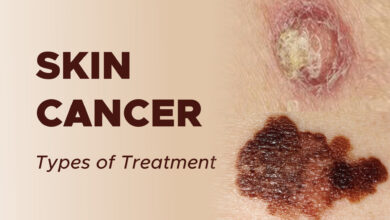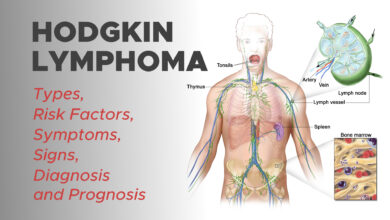
Non Melanoma Skin Cancer: Screening, Symptoms, Signs, Diagnosis and Biopsy
Screening Information, Self Examinations and Biopsy
Screening
Screening is used to look for cancer before you have any symptoms or signs. Scientists have developed, and continue to develop, tests that can be used to screen a person for specific types of cancer before signs or symptoms appear. The overall goals of cancer screening are to:
- Lower the number of people who die from the disease, or eliminate deaths from cancer by identifying cancer at an earlier and more treatable stage
- Lower the number of people who develop the disease
a. Screening Information for Non-melanoma Skin Cancer
Early detection and recognition of skin cancer are very important. More than 75% of non-melanoma skin cancers/keratinocyte carcinomas are diagnosed by patients or their families.
Recognizing the early warning signs of skin cancer and doing regular self-examinations of your skin can help find skin cancer early when the disease is more likely to be cured.
b. Self Examinations
Self-examinations should be performed in front of a full-length mirror in a brightly lit room. It helps to have another person check the scalp and back of the neck.
For people with fair skin, non-melanoma skin cancer most often begins in places that are frequently exposed to the sun. For people with darker skin, squamous cell carcinoma often occurs in areas that are not as frequently exposed to the sun, such as the lower legs.
Include the following steps in a skin self-examination:
- Examine the front and back of the entire body in a mirror, then the right and left sides, with arms raised.
- Bend the elbows and look carefully at the outer and inner forearms, upper arms (especially the hard-to-see back portion), and hands.
- Look at the front, sides, and back of the legs and feet, including the soles and the spaces between the toes.
- Part the hair to lift it and examine the back of the neck and scalp with a hand mirror.
- Check the back, genital area, and buttocks with a hand mirror.
Talk with your doctor if your hairdresser or barber has noticed a suspicious lesion on your scalp or under your beard, or if you find any of the following during self-examination:
- A growth on the skin that matches the symptoms and signs of non-melanoma skin cancer
- New growth on the skin
- A suspicious change in an existing mole or spot
- A sore that does not heal within 2 weeks
Symptoms and Signs
People with basal cell carcinoma, squamous cell carcinoma, or Merkel cell cancer may experience the following symptoms. Sometimes, people with non-melanoma skin cancer/keratinocyte carcinoma do not have any of these changes. Or, the cause of a symptom may be a different medical condition that is not cancer.
Changes in the skin are the main warning sign for skin cancer. Each type of skin cancer can appear differently, so it is important to talk with your doctor when you notice a change in your skin. The skin features that frequently develop are listed below.
a. Basal Cell Carcinoma
For basal cell carcinoma, 2 or more of the following features may be present:
- An open sore that bleeds, oozes, or crusts and remains open for several weeks
- A reddish, raised patch or irritated area that may crust or itch, but rarely hurts
- A shiny pink, red, pearly white, or translucent bump
- A pink growth with an elevated border and crusted central indentation
- A scar-like, white, yellow, or waxy area, often with a poorly defined border
b. Squamous Cell Carcinoma
Squamous cell carcinoma can often crust, bleed, and appear as:
- A wart-like growth
- A persistent, scaly red patch with irregular borders that may bleed easily
- An open sore that persists for weeks
- A raised growth with a rough surface and a central depression
c. Merkel Cell Cancer
Merkel cell cancer often occurs as:
- Painless, firm, shiny lumps on the skin
- These lumps can be red, pink, or blue
Some types of skin cancer spread along the nerves. If this happens, it can cause itching, pain, numbness, tingling, or a feeling like there are ants crawling under the skin. Other signs may include a lump or bump under the skin in areas such as the neck, armpit, or groin.
If you are concerned about any changes you experience, please talk with your doctor. Your doctor will ask how long and how often you’ve been experiencing the symptom(s), in addition to other questions.
This may include when you first noticed the skin feature, how long it has been there, and any other symptoms you may be experiencing. This is to help figure out the cause of the problem, called a diagnosis.
For most cases of skin cancer, removing the cancer with surgery or using a topical treatment will cure the disease. In more complicated cases, a multidisciplinary team of doctors will meet with a patient to discuss different types of treatments to develop a plan with the best chances of curing or controlling this disease
Particularly in advanced skin cancer, relieving symptoms will be an important part of cancer care and treatment. This may be called palliative care or supportive care.
Once started, it is continued throughout treatment. Be sure to talk with your health care team about the symptoms you experience, including any new symptoms or a change in symptoms.
Diagnosis
More than 75% of non-melanoma skin cancers/keratinocyte carcinomas are first noticed by patients or family members, so it is important to bring any suspicious area on your skin to a doctor’s attention.
Doctors use many tests to find or diagnose, cancer. They also do tests to learn if cancer has spread to another part of the body from where it started. If this happens, it is called metastasis. Doctors may also do tests to learn which treatments could work best.
For most types of cancer, a biopsy is the only sure way for the doctor to know if an area of the body has cancer. Your doctor may consider these factors when choosing a diagnostic test:
- The type of cancer suspected
- Your signs and symptoms
- Your age and general health
- The results of earlier medical tests
Biopsy
Because non-melanoma skin cancer rarely spreads, a biopsy is often the only test needed to diagnose and find out the stage, or extent, of cancer. A biopsy is the removal of a small amount of tissue for examination under a microscope.
During this procedure, the suspected skin lesion is removed, usually, after a local anesthetic numbs the area. The doctor also often removes an area of healthy tissue around the lesion, which is called the margin.
The sample removed during the biopsy is then analyzed by a pathologist who determines if it is a skin cancer. A pathologist is a doctor who specializes in interpreting laboratory tests and evaluating cells, tissues, and organs to diagnose disease.
Your doctor will review the results of the biopsy with you. No further treatment beyond the biopsy may be necessary if the entire cancer was removed. However, if cancer cells were found in the margins of the removed tissue, additional treatment will usually be recommended.



